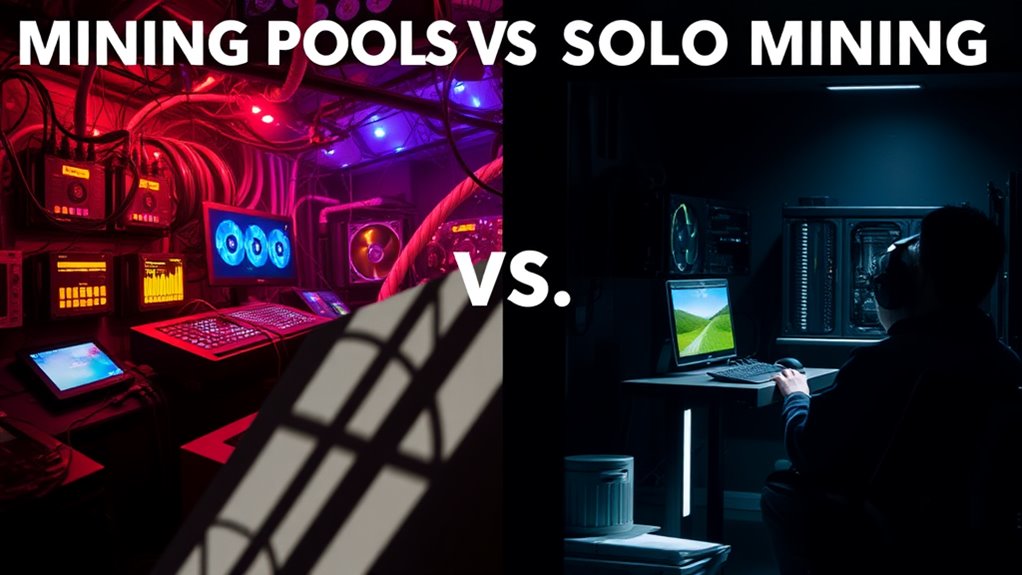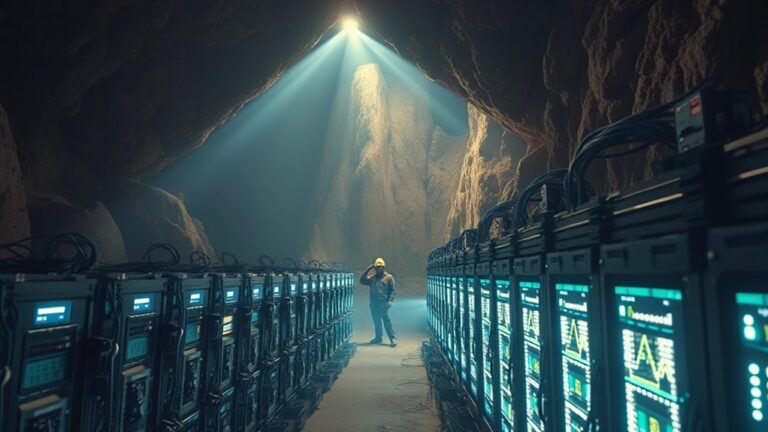
Mining Pools Vs Solo Mining: What’s Best for Your Crypto?
When considering mining pools versus solo mining, both options have clear advantages and disadvantages. Solo mining offers potential for higher rewards and autonomy but requires significant investment and technical expertise. In contrast, pool mining provides stable earnings and shared resources, making it accessible for beginners, but comes with lower individual payouts due to fees. Consequently, individuals must assess their goals, available resources, and risk tolerance to choose the most suitable mining strategy. Additional insights can further clarify this decision.
Key Takeaways
- Solo mining offers full block rewards but requires significant investment in powerful hardware and technical expertise.
- Pool mining provides consistent payouts and reduces the risk of long reward droughts, making it suitable for beginners.
- Solo mining grants greater control over mining operations, while pool mining limits individual configuration choices.
- Consider network difficulty and market volatility when choosing a mining strategy, as they impact profitability significantly.
- Weigh the risks and rewards: solo mining has higher potential returns but greater risk, whereas pool mining offers stability but smaller individual payouts.
Understanding Solo Mining

Solo mining is a distinct approach in the cryptocurrency mining landscape, where individual miners operate independently to solve cryptographic puzzles without the support of a mining pool.
This method requires powerful hardware, such as ASIC miners, to compete effectively in a highly competitive environment. Miners connect their equipment directly to the blockchain, using specialized software to solve complex puzzles that validate new blocks.
Successful solo miners receive the entire block reward and transaction fees, but the process carries significant risks due to the unpredictability of finding blocks. High resource costs and technical expertise are essential, as maintaining and upgrading hardware can impact overall success. Additionally, solo mining plays a critical role in the security and decentralization**** of cryptocurrency networks.
Despite the challenges, solo mining contributes to the decentralization of cryptocurrency networks.
Exploring Pool Mining

Mining pools represent a collaborative approach in the cryptocurrency mining arena, where multiple users join forces to enhance their chances of successfully mining blocks.
These pools serve as platforms that combine the computing power of various miners, increasing the likelihood of finding blocks compared to solo efforts. Participants receive rewards based on their contributed computing power, with pools utilizing different payment structures such as Pay-Per-Share (PPS) or Pay-Per-Last-N-Shares (PPLNS).
Mining pools unite the computing power of multiple miners, enhancing block discovery chances and offering rewards based on individual contributions.
While pools charge operational fees ranging from 0.1% to 5%, careful selection is essential to avoid hidden fees or fraud.
Additionally, pools manage work assignments and distribute rewards, providing a more stable income source and reducing individual financial risk in the volatile cryptocurrency market. Furthermore, miners in pools can reduce costs by optimizing their operations through energy-efficient strategies, which can enhance overall profitability.
Advantages of Solo Mining

While many miners choose to join pools for collaborative advantages, solo mining presents a distinct set of benefits that can appeal to certain individuals.
One significant advantage is the potential for higher rewards, as solo miners retain full block rewards and transaction fees without needing to share with others. This can lead to increased long-term profitability for those who consistently mine blocks.
Additionally, solo mining grants complete autonomy over operations, allowing individuals to customize their mining strategies and avoid pool fees.
Privacy and security benefits arise as well, including reduced risks associated with centralized pools. Moreover, the profitability of solo mining can be influenced by factors such as Bitcoin’s price volatility, which underscores the importance of market awareness in maximizing returns.
Disadvantages of Solo Mining

Engaging in solo mining can present several significant disadvantages that potential miners should carefully consider.
The initial costs for high-quality mining equipment, such as the Antminer S21, can exceed $7,500, not including high electricity costs. The increasing difficulty of networks makes it challenging for solo miners to find blocks, often resulting in long periods without rewards.
Additionally, the lack of technical support can complicate setup and maintenance, requiring advanced knowledge and time to manage issues independently. Market volatility can further impact profitability, as fluctuating prices may diminish earnings. Furthermore, successful mining often depends on selecting the right GPU based on hash rate, which is crucial for optimizing performance.
Finally, operational risks, such as equipment failure or overheating, can lead to substantial losses, making solo mining a less appealing option for many.
Benefits of Pool Mining

Pool mining offers distinct advantages, particularly regarding stable earnings and collective mining power.
By joining a mining pool, participants can benefit from consistent payouts, as rewards are shared based on individual contributions, reducing the uncertainty often associated with solo mining.
Furthermore, the combined computational strength of many miners increases the likelihood of successfully finding blocks, enhancing overall mining efficiency and profitability. Additionally, participating in a pool can provide insights into pool fees and other key factors that impact overall returns.
Stable Earnings Assurance
Stability in earnings is a significant advantage of participating in mining pools. These pools offer consistent income through regular block discoveries, making financial planning easier for miners.
By combining resources, mining pools reduce downtime, guaranteeing continuous operation and minimizing the risks associated with solo mining, such as prolonged block finding times. This collective effort results in predictable rewards, which further enhance stability.
Additionally, mining pools help to stabilize earnings even during market fluctuations, allowing participants to manage risks more effectively. Overall, the structure of mining pools fosters a reliable income stream, which is particularly beneficial for those looking to secure a steady return on their investment in the volatile cryptocurrency market. Furthermore, because mining pools verify transactions collectively, they contribute to the overall security and integrity of the blockchain network.
Collective Mining Power
Mining pools offer a significant advantage through the concept of collective mining power, which enhances the effectiveness of cryptocurrency mining operations. By combining resources, miners increase their chances of successfully finding new blocks, as greater computational power leads to a higher likelihood of solving complex cryptographic puzzles.
Large mining pools, such as FoundryDigital, provide substantial hashing power, reducing reliance on individual luck. Additionally, pool mining lowers the barrier for small-scale miners, allowing participation with existing hardware while sharing costs for equipment and electricity.
This collaborative approach simplifies the technical aspects of mining, making it accessible for newcomers. Furthermore, fair reward distribution systems guarantee that earnings correspond to each member’s contributed hashing power, fostering a sense of community and support. Moreover, miners can benefit from cloud mining options that allow them to leverage third-party resources without the need for significant hardware investments.
Drawbacks of Pool Mining

In the domain of cryptocurrency, participating in a mining pool offers certain advantages, but it also comes with notable drawbacks that miners should carefully consider.
One significant concern is the fees, which typically range from 1% to 4% of mined rewards, reducing overall profitability. Additionally, rewards are shared among members, leading to smaller individual payouts. Some pools enforce minimum payout thresholds, delaying payments for smaller miners.
Fees can reach 4% of mined rewards, diminishing profits, while shared payouts and minimum thresholds can delay earnings for smaller miners.
Security risks arise from centralization, as large pools can be vulnerable to attacks. Miners also face limited control over settings and inflexible payout structures.
Moreover, pool reliability can impact earnings, as any downtime or technical issues may disrupt operations. These factors collectively challenge the attractiveness of pool mining for some participants. To further safeguard against potential issues, it’s essential to be aware of cryptocurrency mining scams, as they can exploit the vulnerabilities of pool structures.
Making the Right Choice for Your Mining Strategy

Choosing the right mining strategy is a pivotal decision for anyone involved in cryptocurrency. Miners must weigh the benefits of solo mining against those of pool mining to determine the best fit for their needs. Key considerations include risk tolerance, hardware capabilities, and market conditions, which can greatly influence profitability. Additionally, understanding the impact of halvings on mining profitability is crucial for making informed decisions.
| Aspect | Solo Mining | Pool Mining |
|---|---|---|
| Earnings Potential | Full block rewards, higher returns | Consistent, shared rewards |
| Control | Greater autonomy | Less control |
| Costs | Higher upfront and operational costs | Lower entry barrier, shared costs |
| Risk | Higher risk, variable returns | Lower risk, predictable income |
Ultimately, a miner’s experience and goals will guide their decision, whether seeking independence or stability in their mining approach.
Frequently Asked Questions
How Does Mining Difficulty Affect Solo and Pool Mining?
Mining difficulty greatly impacts both solo and pool mining. Higher difficulty increases the risk of inactivity for solo miners, while pools can adapt collectively, resulting in more consistent rewards and reduced individual risk for participants.
What Hardware Is Recommended for Solo Mining?
In the quest for glory, aspiring solo miners often turn to ASIC miners for Bitcoin or versatile GPUs for altcoins. Yet, low-power options like mini miners cleverly offer a humorous twist on efficiency and simplicity.
Are There Tax Implications for Mining Earnings?
Tax implications for mining earnings include reporting rewards as taxable income, potential capital gains if values increase, and varying tax forms depending on whether mining is classified as a hobby or a business. Detailed record-keeping is essential.
Can I Switch From Pool to Solo Mining Easily?
Switching from pool to solo mining may seem like a leap into an abyss of uncertainty. However, with proper preparation and understanding, miners can navigate this change, balancing risk and reward effectively for potential gains.
What Cryptocurrencies Are Best for Solo Mining Currently?
Currently, cryptocurrencies like Monero, Litecoin, and Dogecoin are suitable for solo mining. These options offer relatively lower mining difficulties, making them more accessible for individuals with adequate hardware and a willingness to invest in setups.
Conclusion
In conclusion, choosing between solo mining and pool mining presents distinct paths in the cryptocurrency landscape. Solo mining offers the allure of complete control and potential high rewards, yet it demands significant resources and carries a higher risk of failure. Conversely, pool mining provides a collaborative approach, yielding more consistent payouts with reduced individual effort, though it requires sharing rewards. Weighing these factors is essential for miners to align their strategies with their goals and resources.












